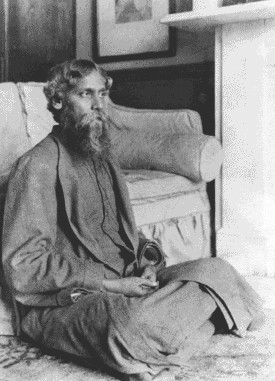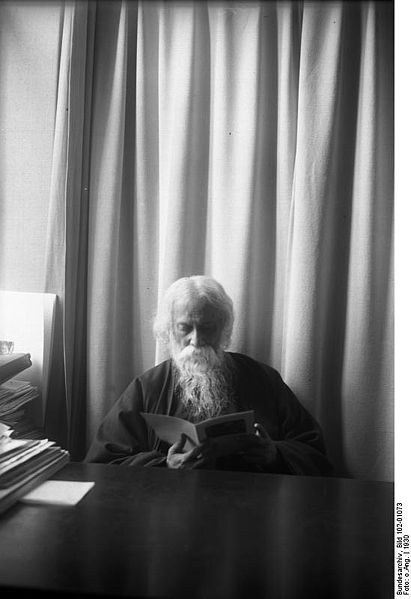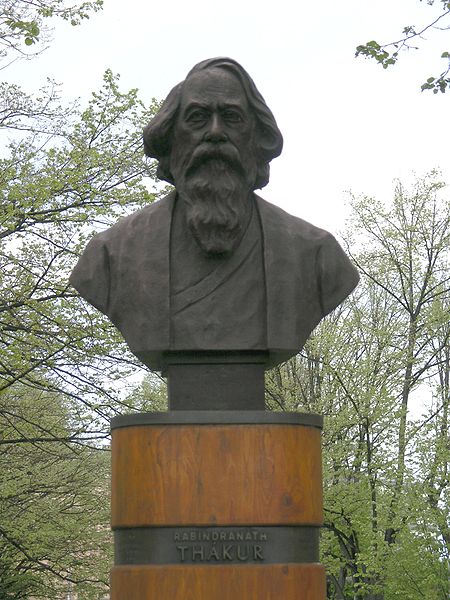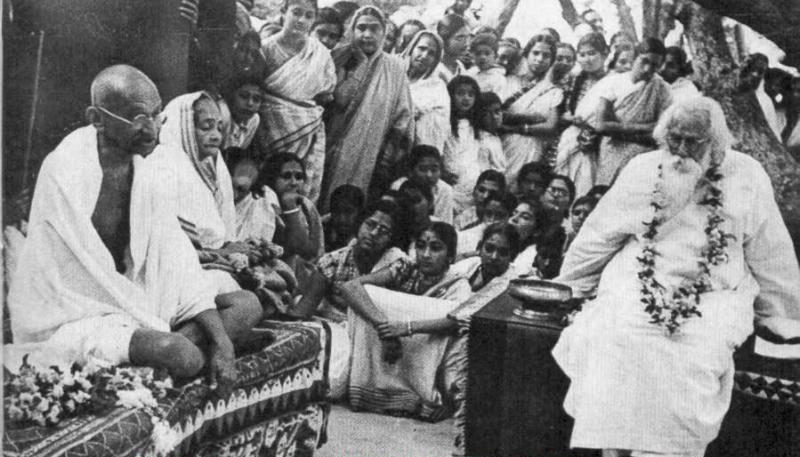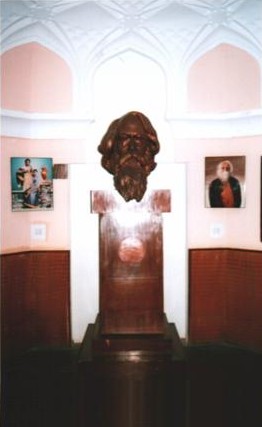<Back to Index>
- Philosopher, Polymath and Writer Rabindranath Tagore, 1861
- Composer Johannes Brahms, 1833
- President of the Socialist Federal Republic of Yugoslavia Josip Broz Tito, 1892
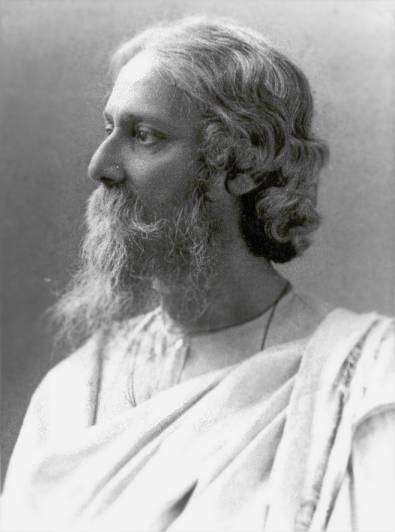
Rabindranath Tagore (7 May 1861 – 7 August 1941) was a Bengali polymath. As a poet, novelist, musician, and playwright, he reshaped Bengali literature and music in the late 19th and early 20th centuries. Tagore was perhaps the most important literary figure in the history of Bengali literature. In 1913, as author of Gitanjali, noted for its "profoundly sensitive, fresh and beautiful verse," he became the first non-European to win the Nobel Prize in Literature. He was also a mesmerising representative of the Indian culture whose influence and popularity internationally perhaps could only be compared to that of Gandhi, whom Tagore named 'Mahatma' out of his deep admiration for him.
A Pirali Brahmin from Calcutta, Tagore was already writing poems at age eight. At age sixteen, he published his first substantial poetry under the pseudonym Bhanushingho ("Sun Lion") and
wrote his first short stories and dramas in 1877. Tagore denounced the
British Raj and supported independence. His efforts endure in his vast
canon and in the institution he founded, Visva-Bharati University. Tagore
modernised Bengali art by spurning rigid classical forms. His novels,
stories, songs, dance-dramas, and essays spoke to political and
personal topics. Gitanjali (Song Offerings), Gora (Fair-Faced), and Ghare-Baire (The Home and the World)
are his best-known works, and his verse, short stories, and novels were
acclaimed for their lyricism, colloquialism, naturalism, and
contemplation. Tagore was perhaps the only litterateur who penned
anthems of two countries: Bangladesh and India: Amar Shonar Bangla and Jana Gana Mana. The youngest of thirteen surviving children, Tagore was born in the Jorasanko mansion in Kolkata of parents Debendranath Tagore (1817–1905) and Sarada Devi (1830–1875). Tagore family patriarchs were the Brahmo founding fathers of the Adi Dharm faith. He was mostly raised by servants, as his mother had died in his early childhood; his father travelled extensively. Tagore largely declined classroom schooling, preferring to roam the mansion or nearby idylls: Bolpur, Panihati, and others. Upon his upanayan initiation
at age eleven, Tagore left Kolkata on 14 February 1873 to tour India
with his father for several months. They visited his father's Santiniketan estate
and stopped in Amritsar before reaching the Himalayan hill station of
Dalhousie. There, young "Rabi" read biographies and was home-educated
in history, astronomy, modern science, and Sanskrit, and examined the
poetry of Kālidāsa. He completed major works in 1877, one a long poem of the Maithili style pioneered by Vidyapati. Published pseudonymously, experts accepted them as the lost works of Bhānusiṃha, a newly discovered 17th-century Vaiṣṇava poet. He wrote "Bhikharini" (1877; "The Beggar Woman"—the Bengali language's first short story) and Sandhya Sangit (1882)—including the famous poem "Nirjharer Swapnabhanga" ("The Rousing of the Waterfall"). A
prospective barrister, Tagore enrolled at a public school in Brighton,
East Sussex, England in 1878. He read law at University College London,
but left school to explore Shakespeare and more: Religio Medici, Coriolanus, and Antony and Cleopatra; he
returned degreeless to Bengal in 1880. On 9 December 1883 he married
Mrinalini Devi (born Bhabatarini, 1873–1900); they had five children,
two of whom died before reaching adulthood. In
1890, Tagore began managing his family's vast estates in Shilaidaha, a
region now in Bangladesh; he was joined by his wife and children in
1898. In 1890, Tagore released his Manast poems, among his best-known work. As "Zamindar Babu", Tagore crisscrossed the holdings while living out of the family's luxurious barge, the Padma, to collect (mostly token) rents and bless villagers, who held feasts in his honour. These years—1891–1895: Tagore's Sadhana period, after one of Tagore’s magazines—were his most fecund. During this period, more than half the stories of the three-volume and eighty-four-story Galpaguchchha were written. With irony and gravity, they depicted a wide range of Bengali lifestyles, particularly village life. In 1901, Tagore left Shilaidaha and moved to Santiniketan to found an ashram which grew to include a marble-floored prayer hall ("The Mandir"), an experimental school, groves of trees, gardens, and a library. There,
Tagore's wife and two of his children died. His father died on 19
January 1905. He received monthly payments as part of his inheritance
and additional income from the Maharaja of Tripura, sales of his
family's jewellery, his seaside bungalow in Puri, and mediocre
royalties (Rs. 2,000) from his works. By now, his work was gaining him a large following among Bengali and foreign readers alike, and he published such works as Naivedya (1901) and Kheya (1906)
while translating his poems into free verse. On 14 November 1913,
Tagore learned that he had won the 1913 Nobel Prize in Literature,
becoming the first Asian Nobel laureate. The Swedish Academy appreciated
the idealistic and—for Western readers—accessible nature of a small
body of his translated material, including the 1912 Gitanjali: Song Offerings. In
1915, Tagore was knighted by the British Crown. He later returned his
knighthood in protest of the massacre of unarmed Indians in 1919 at Jallianwala Bagh. In 1921, Tagore and agricultural economist Leonard Elmhirst set
up the Institute for Rural Reconstruction, later renamed
Shriniketan — "Abode of Peace" — in Surul, a village near the ashram at
Santiniketan. Through it, Tagore bypassed Gandhi's symbolic Swaraj protests, which he despised. He
sought aid from donors, officials, and scholars worldwide to "free
village[s] from the shackles of helplessness and ignorance" by
"vitalis[ing] knowledge". In
the early 1930s, he targeted India's "abnormal caste consciousness" and
untouchability. Lecturing against these, he penned untouchable heroes
for his poems and dramas and campaigned—successfully—to open Guruvayoor Temple to Dalits. To
the end, Tagore scrutinized orthodoxy. He upbraided Gandhi for
declaring that a massive 15 January 1934 earthquake in Bihar—leaving
thousands dead—was divine retribution brought on by the oppression of Dalits. He
mourned the endemic poverty of Calcutta and the accelerating
socioeconomic decline of Bengal, which he detailed in an unrhymed
hundred-line poem whose technique of searing double-vision would
foreshadow Satyajit Ray's film Apur Sansar. Fifteen new volumes of Tagore writings appeared, among them the prose-poems works Punashcha (1932), Shes Saptak (1935), and Patraput (1936). Experimentation continued: he developed prose-songs and dance-dramas, including Chitrangada (1914), Shyama (1939), and Chandalika (1938), and wrote the novels Dui Bon (1933), Malancha (1934), and Char Adhyay (1934). Tagore took an interest in science in his last years, writing Visva-Parichay (a
collection of essays) in 1937. His exploration of biology, physics, and
astronomy impacted his poetry, which often contained extensive
naturalism that underscored his respect for scientific laws. He also
wove the process of science, including narratives of scientists, into
many stories contained in such volumes as Se (1937), Tin Sangi (1940), and Galpasalpa (1941). Tagore's
last four years were marked by chronic pain and two long periods of
illness. These began when Tagore lost consciousness in late 1937; he
remained comatose and near death for an extended period. This was
followed three years later, in late 1940, by a similar spell, from
which he never recovered. The poetry Tagore wrote in these years is
among his finest, and is distinctive for its preoccupation with death. After extended suffering, Tagore died on 7 August 1941 (22 Shravan 1348) in an upstairs room of the Jorasanko mansion in which he was raised; his death anniversary is mourned across the Bengali-speaking world.
Between 1878 and 1932, Tagore visited more than thirty countries on five continents; many
of these trips were crucial in familiarising non-Indian audiences to
his works and spreading his political ideas. In 1912, he took a sheaf
of his translated works to England, where they impressed missionary and
Gandhi protégé Charles F. Andrews, Anglo-Irish poet William Butler Yeats, Ezra Pound, Robert Bridges, Ernest Rhys, Thomas Sturge Moore, and others. Indeed,
Yeats wrote the preface to the English translation of Gitanjali, while
Andrews joined Tagore at Santiniketan. On 10 November 1912, Tagore
began touring the United States and the United Kingdom, staying in Butterton, Staffordshire with Andrews’ clergymen friends. From 3 May 1916 until April 1917, Tagore went on lecturing circuits in Japan and the United States and denounced nationalism. His essay "Nationalism in India" was scorned and praised, this latter by pacifists, including Romain Rolland.
Shortly
after returning to India, the 63-year-old Tagore accepted the Peruvian
government's invitation to visit. He then travelled to Mexico. Each
government pledged US$100,000 to the school at Shantiniketan
(Visva-Bharati) in commemoration of his visits. A week after his 6 November 1924 arrival in Buenos Aires, Argentina, an ill Tagore moved into the Villa Miralrío at the behest of Victoria Ocampo. He left for India in January 1925. On 30 May 1926, Tagore reached Naples, Italy; he met Benito Mussolini in Rome the next day. A warm rapport ended when Tagore criticised Mussolini on 20 July 1926.
On
14 July 1927, Tagore and two companions began a four-month tour of
Southeast Asia, visiting Bali, Java, Kuala Lumpur, Malacca, Penang,
Siam, and Singapore. Tagore's travelogues from the tour were collected
into the work "Jatri". In
early 1930 he left Bengal for a nearly year-long tour of Europe and the
United States. Once he returned to the UK, while his paintings were
being exhibited in Paris and London, he stayed at a Friends settlement
in Birmingham. There he wrote his Oxford Hibbert Lectures and spoke at London's annual Quaker gathering. There
(addressing relations between the British and Indians, a topic he would
grapple with over the next two years), Tagore spoke of a "dark chasm of
aloofness". He visited Aga Khan III, stayed at Dartington Hall, and toured Denmark, Switzerland, and Germany from June to mid-September 1930, then the Soviet Union. Lastly, in April 1932, Tagore — who was acquainted with the legends and works of the Persian mystic Hafez — was hosted by Reza Shah Pahlavi of Iran. Such extensive travels allowed Tagore to interact with many notable contemporaries, including Henri Bergson, Albert Einstein, Robert Frost, Thomas Mann, George Bernard Shaw, H.G. Wells and Romain Rolland. Tagore's
last travels abroad, including visits to Persia and Iraq (in 1932) and
Ceylon in 1933, only sharpened his opinions regarding human divisions
and nationalism. Tagore's political thought was complex. He opposed imperialism and supported Indian nationalists. His views have their first poetic release in Manast, mostly composed in his twenties. Evidence produced during the Hindu-German Conspiracy trial and later accounts affirm his awareness of the Ghadarite conspiracy, and stated that he sought the support of Japanese Prime Minister Terauchi Masatake and former Premier Ōkuma Shigenobu. Yet he lampooned the Swadeshi movement, denouncing it in "The Cult of the Charka", an acrid 1925 essay. He
emphasized self-help and intellectual uplift of the masses as an
alternative, stating that British imperialism was a "political symptom
of our social disease", urging Indians to accept that "there can be no
question of blind revolution, but of steady and purposeful education". Such
views enraged many. He narrowly escaped assassination by Indian
expatriates during his stay in a San Francisco hotel in late 1916. The
plot failed only because the would-be assassins fell into argument. Yet Tagore wrote songs lionizing the Indian independence movement and renounced his knighthood in protest against the 1919 Jallianwala Bagh Massacre. Two of Tagore's more politically charged compositions, "Chitto Jetha Bhayshunyo" ("Where the Mind is Without Fear") and "Ekla Chalo Re" ("If They Answer Not to Thy Call, Walk Alone"), gained mass appeal, with the latter favoured by Gandhi. Despite his tumultuous relations with Gandhi, Tagore was key in resolving a Gandhi-Ambedkar dispute involving separate electorates for untouchables, ending Gandhi's fast "unto death". Tagore lampooned rote schooling: in "The Parrot's Training", a bird is caged and force-fed pages torn from books until it dies. These
views led Tagore, while visiting Santa Barbara on 11 October 1917, to
conceive of a new type of university, desiring to "make Santiniketan
the connecting thread between India and the world [and] a world center
for the study of humanity somewhere beyond the limits of nation and
geography." The school, which he named Visva-Bharati had its foundation stone laid on 22 December 1918; it was later inaugurated on 22 December 1921. Here, Tagore implemented a brahmacharya pedagogical structure employing gurus to
provide individualised guidance for pupils. Tagore worked hard to
fundraise for and staff the school, even contributing all of his Nobel
Prize monies. Tagore’s
duties as steward and mentor at Santiniketan kept him busy; he taught
classes in mornings and wrote the students' textbooks in afternoons and
evenings. Tagore also fundraised extensively for the school in Europe and the U.S. between 1919 and 1921.
